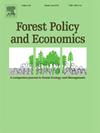Navigating crowds: Reconsidering visitor recreational experience and crowding preference for a forest park in Taiwan
IF 3.8
2区 农林科学
Q1 ECONOMICS
引用次数: 0
Abstract
As forest recreational activities gain popularity, the potential for crowding and activity-based conflicts to diminish sustainable recreational quality becomes a critical concern. Consequently, it is vital to understand the factors shaping recreational preferences and conflict perceptions in natural settings. This study selected Xitou Nature Education Area, Taiwan's most frequented forest park, as a case study to investigate complex relationships among visitor demographics, crowding perceptions, and recreational behaviors. Using a questionnaire and choice experiment, the study explored perceptions of crowding and recreational conflicts within Xitou, alongside visitors' willingness to travel further to avoid crowded conditions. The analysis showed that visitor preferences differed significantly across socioeconomic groups, with age playing a substantial role in shaping motivations and behaviors. While overall perceptions of crowding were moderate, visitors aged 65 and older demonstrated notable tolerance for crowds. Despite the park's high visitation, the incidence of recreational conflict was relatively low, with primary disturbances attributed to visitors resting in various locations, park staff, and group game participants. Contrary to expectations, visitors did not exhibit strong willingness to pay to avoid crowding. Instead, results surprisingly suggested a slight preference for increased social interaction within the park, challenging the general assumption that crowding is always viewed negatively. Drawing from visitor perceptions of overcrowding, we propose enhanced regulations and stricter monitoring for designated resting and picnicking areas to elevate the forest recreation experience. Crucially, this study highlights that effective park management must acknowledge and cater to diverse visitor motivations, whether they seek physical activity, social engagement, or solitude.
人群导航:台湾森林公园游客休闲体验与拥挤偏好的再思考
随着森林娱乐活动越来越受欢迎,潜在的拥挤和基于活动的冲突降低了可持续的娱乐质量成为一个关键问题。因此,了解在自然环境中形成娱乐偏好和冲突感知的因素至关重要。本研究以台湾游客最多的森林公园西头自然教育区为研究对象,探讨游客人口统计、拥挤感与游憩行为之间的复杂关系。通过问卷调查和选择实验,该研究探讨了西头地区对拥挤和娱乐冲突的看法,以及游客为了避免拥挤而前往更远的地方的意愿。分析显示,不同社会经济群体的游客偏好差异很大,年龄在塑造动机和行为方面起着重要作用。虽然对拥挤的总体看法是中等的,但65岁及以上的游客对拥挤表现出明显的容忍度。尽管公园的访问量很大,但娱乐冲突的发生率相对较低,主要的干扰归因于在不同地点休息的游客、公园工作人员和团体游戏参与者。与预期相反,游客并没有表现出强烈的付费意愿来避免拥挤。相反,结果令人惊讶地表明,人们对公园内增加的社交互动有轻微的偏好,这挑战了通常认为拥挤总是被视为负面的假设。根据游客对过度拥挤的看法,我们建议加强对指定休息和野餐区域的监管和严格监控,以提升森林休闲体验。至关重要的是,这项研究强调,有效的公园管理必须承认并迎合游客的不同动机,无论他们是寻求体育活动、社交活动还是独处。
本文章由计算机程序翻译,如有差异,请以英文原文为准。
求助全文
约1分钟内获得全文
求助全文
来源期刊

Forest Policy and Economics
农林科学-林学
CiteScore
9.00
自引率
7.50%
发文量
148
审稿时长
21.9 weeks
期刊介绍:
Forest Policy and Economics is a leading scientific journal that publishes peer-reviewed policy and economics research relating to forests, forested landscapes, forest-related industries, and other forest-relevant land uses. It also welcomes contributions from other social sciences and humanities perspectives that make clear theoretical, conceptual and methodological contributions to the existing state-of-the-art literature on forests and related land use systems. These disciplines include, but are not limited to, sociology, anthropology, human geography, history, jurisprudence, planning, development studies, and psychology research on forests. Forest Policy and Economics is global in scope and publishes multiple article types of high scientific standard. Acceptance for publication is subject to a double-blind peer-review process.
 求助内容:
求助内容: 应助结果提醒方式:
应助结果提醒方式:


